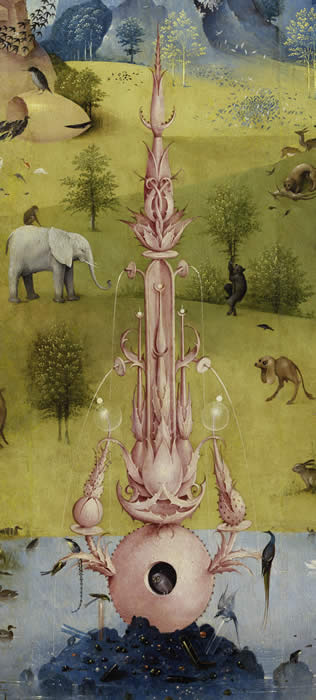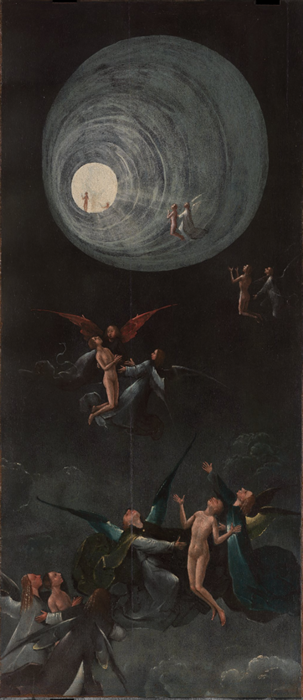
Bosch and Swedenborg
Once one understands the question of divine revelation and how it has influenced human views of metaphysics and cosmology, one finds it impossible to divorce this subject from the question of Hieronymus Bosch and his paintings. The Garden of Earthly Delights, above all his other works, illustrates a definite influence of divine revelation, which is why the painting has fascinated men for so many centuries. Because of the level it came from, it is actually possible for it to exert its heavenly and spiritual influences through its imagery. This has a magnetic effect even on men who have lost nearly all contact with the inflow of the divine within themselves.
The painting does not just rival, but surpasses, the written works from its own and earlier centuries that stem from this kind of revelation, because it's able to produce this effect instantaneously through a powerful visual impression, which reaches into a deeper (and hence higher) level of man than the rational intellect. It thus presents in a uniquely individual form that other artists have never been able to attain or imitate, precisely because of this quality. No one else can paint a painting on this order unless they have been inspired by the same source.
It must be stressed that divine revelation, according to esoteric understandings, always comes from the same higher source, and cannot vary in its essential content, regardless of the century that it arrives in or the words it is expressed in. One must, in other words, take into account that the language of different centuries and societies will vary; but the message, and the cosmology, must be the same. There can be no disagreement, as Gurdjieff explained to Ouspensky..
There can be no doubt that the divine revelations of Ibn 'Arabi— who inspired countless generations of Sufis, down to the present day, and who still stands as the greatest Islamic thinker, philosopher, and religious figure in history, outside of Mohammed himself — Meister Eckhart, the seminal source of the deepest esoteric Christian understanding, and Emmanuel Swedenborg all came from the same source of divine revelation, that is, an inner insight sent to each of these individuals from a higher level of understanding. Scholars have returned repeatedly to comment on the many striking similarities between the three, finding it remarkable; yet there is nothing remarkable about it.
Bosch's cosmology and his understanding of man's nature come from the same source; and a comparison to a few passages from Emanuel Swedenborg's Heaven and Hell will well serve to illuminate Bosch's understanding, and exactly what he was painting when he painted the Garden of Earthly Delights. The painting fits into a specific and known set of esoteric understandings.
The fact that these two men were separated by centuries means absolutely nothing, since the source of their revelation is the same. Such revelatory understandings cannot vary from century to century, regardless of who may express them. The ideas in a true revelation from a higher source are unmistakable to those who understand the message that is being conveyed.
The advantage of using Swedenborg as our chief point of comparison is that his remarkably lucid scientific mind managed to convey the essentials of such revelations, along with most of the truths they convey, in a very organized and understandable manner, well-suited to the Western mind. Swedenborg was chosen to receive his revelations specifically because he had the ability to do this; just as Ibn 'Arabi and Eckhart were divinely inspired in a manner entirely appropriate to their own age and culture, and because of their abilities to transmit what they received.
Bosch happens to have been an extraordinarily gifted transmitter of the revelation that he received. It is no fault of his own that he has been so consistently misunderstood; his discourse was at a very high level, and discourses of this nature always echo through time as mysteries, leaving those who follow in a struggle to reach understanding of them.
The Garden of Earthly Delights, in a supreme irony, appears to be an extremely subjective painting, but it is, in fact, what Gurdjieff would have called objective art. It not only lays out a foundational cosmology describing the nature of man and the universe; it also describes the process whereby man's divinely created Being deteriorates and ultimately destroys itself because of its "rational" nature, a process Swedenborg described in some detail.
Swedenborg's premise about the nature of material reality is founded on the understanding that all of material reality is created through what he called inflow of heavenly and spiritual influences. Bosch illustrated this process in a spectacular manner in the left-hand panel of the Garden of earthly delights.

The painting appears, in some ways, to be an almost doctrinal interpretation of some of Swedenborg's ideas, even though it predates them by nearly 3 centuries. The idea, for example, of correspondences between heavenly and earthly things is illustrated in considerable detail, beginning with the elements of the mineral kingdom at the bottom of the column.
The entire painting, while consisting of a deep and exhaustive illustration of divine influences on the natural world, also goes to great lengths to show the deterioration of man's existence as a result of his rational being. Swedenborg had the following comments on the subject, beginning with the fact that animal instinct was divinely inspired:
"...Bees know how to collect honey from flowers... they live under a kind of government that all their members know instinctively... caterpillars... know how to nourish themselves with the sap of their leaves... the fowl of the air know the foods that are good for them — not only what they are but where they are...
The reason why earthbound animals and the fowl of the air are born into all this knowledge while we, who are actually superior, are not, is that animals are in the proper pattern of their life and cannot destroy what is within them from the spiritual world because they are not rational. It is different for us, who think from the spiritual world. Because we have corrupted ourselves by living contrary to the design that reason itself has recommended to us, we cannot escape being born into total ignorance, so that we can be led from there, by divine means, back into the pattern of heaven."
—Heaven and Hell, page 142.
Swedenborg goes on to describe the fall of man through successive ages, beginning with a golden age in which man was in the company of angels and talked with them, uniting heaven in the world. This was followed by a silver age, in which people did not think from actual correspondences but just from a knowledge of them. Ultimately, the next people who came were familiar with correspondences but did not do their thinking on the basis of them, because they were engrossed in what is good on the natural level. This age was called the Bronze Age, which is what Bosch has illustrated in his central panel.
The final age is the age we see in the right-hand panel, at which point humanity "became more and more externally minded and at last physically minded. Then the knowledge of correspondences was completely lost, and with it any awareness of Heaven and its riches." (ibid, p. 147)
Bosch has, in other words, given us a picture of the steady loss of Divine influence upon mankind and his actions, illustrating not the exterior deterioration, but the gradual inner decay of man's Being. Man's Being is a representative of the Divine on earth a —point that both Swedenborg, Eckhart, and Ibn 'Arabi made much of — and the issue of man's fall from Grace is not just an outer one, connected to the tragedy of his outer action.
All of these esoteric Masters—including Bosch — well understood that the fall from Grace was an inner fall from Grace, and that all of the outer actions and questions that arose from it arose, essentially and fundamentally, from a separation between man and God, in his inner Being.
Bosch, however, delved even deeper into Swedenborg's territory, long before he came along. Swedenborg has been acknowledged as one of the very first persons, scientists or otherwise, to describe what is known as the near-death experience, or NDE. The near-death experience, an experience many people who are brought to the brink of death (or, supposedly, even past it) report with consistent details, often involves seeing a tunnel of light, and being met by angels at the other side.
The far right-hand panel of Bosch's painting Four Visions of the Hereafter from the Palazzo Grimani in Venice offers us a near-perfect representation of the vision Swedenborg spoke about when he discussed his many trips to heaven.

This stunning image, perhaps more than any other, indicates that Bosch had, almost beyond doubt, received divine revelation from the same sources that Swedenborg claims he gained his information from. The men were in the same line of an esoteric tradition that stretches back through the ages; and Bosch's paintings, if they are anything, are a record of a most extraordinary vision of inner truths that were imparted from sources beyond anything known on earth.
One has to leave it to the philosophers, psychologists, priests, and shamans to judge whether or not these revelations have any basis in fact. Certainly, what they do have a basis in is conviction— Bosch painted with enormous conviction, and Swedenborg wrote with it. Each one of them imparted a similar vision; one with paint, one with words — but their message is the same.
We ignore their lesson, they tell us, at the peril of our souls.
A Doremishock resource
Contact
All material copyright 2013 by Lee van Laer. This work may not be reproduced without permission.